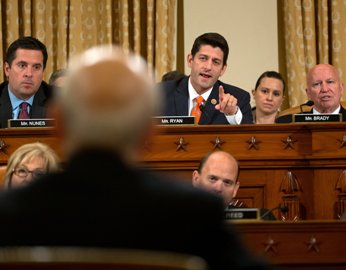“I don’t believe you.”
Why anyone, in their right mind, would want to head anygovernment agency in today’s hyper-partisan world is beyond my understanding. Just look at what you have to stare-down when you’re sitting before a congressional committee.
On December 23, 2013, John Koskinen was sworn in as the new IRS commissioner after being confirmed by the Senate three days earlier.

Exactly six months later, Koskinen found himself sitting before the House Oversight Committee. Koskinen was there, The New York Times reports (June 23), “to answer questions about how two years’ worth of emails sent and received by Lois Lerner, the former official at the center of a growing I.R.S. scandal, could have been destroyed, and why the agency waited until just recently to tell Congress.
Three days earlier (June 20), however, the IRS chief sat through a hearing “before the tax-writing House Ways and Means Committee, [where] Republicans accused the I.R.S. of ‘stonewalling,’ ‘obstruction’ and ‘deceit.’ Representative Paul D. Ryan of Wisconsin… effectively called Mr. Koskinen a liar, telling him, ‘I don’t believe you.’
House Republicans have turned an investigation into an obvious scandal of abuse of power into their own personal inquisition, (absent the fun-loving dance routine from the Mel Brooks movie). Clearly overplaying their hand, Republicans cite the missing e-mails as the “smoking gun,” the missing 18 1/2 minute gap in the Nixon tapes, and the reason why Washington’s theater district is suffering from lack of sales because on Capitol Hill, they don’t charge for theater tickets.
“No one believes you,” Ryan said. Now “you don’t have the e-mails. Hard drives crashed. You learned about this months ago. You just told us. And we had to ask you on Monday,” he continued. “This is not being forthcoming. This is being misleading again. This is a pattern of abuse.”
“Mr. Koskinen replied” The Times writes, “that in his ‘long career,’ ‘That’s the first time anybody has said they do not believe me.’
“After a series of interruptions, Representative Sander M. Levin of Michigan, the top Democrat on the panel, said, ‘Will you let him answer the question?’
” ‘I didn’t ask him a question,’ Mr. Ryan said.
” ‘Yes, you did,’ Mr. Levin replied.
“Mr. Koskinen disputed the contention voiced by Mr. Ryan and others on the committee that the delay in notifying investigators about the computer crashes, and the fact that the agency notified the Treasury Department weeks earlier, were indicative of a cover-up.
“[He] submitted as evidence an email exchange from 2011 between the agency’s technology staff and Lois Lerner, the former I.R.S. official at the center of the inquiry, in which she sought to have her messages restored.
“He said that Ms. Lerner’s computer crash and the effort to retrieve her lost messages had occurred before the agency was notified that Congress was receiving complaints from conservative political groups that they were being unfairly scrutinized, undercutting the notion that emails were deliberately destroyed.
“Mr. Koskinen also pointed to a report by an inspector general of the Treasury Department, the parent agency of the I.R.S., which concluded that while agency employees had acted improperly, there was no evidence of political motivation or outside influence.
“Democrats on the committee said the committee’s inquiry was missing a larger point: that political groups of all kinds were effectively getting subsidies from taxpayers as ‘social welfare groups,’ even though they were actually engaged in campaigning for political candidates.”
Republicans want to determine if the e-mails demonstrate a pattern of mistreatment by the IRS in targeting conservative groups and if the White House was behind it.
How many Lerner e-mails are missing?
“It is impossible to know for sure, because the agency says that the emails in question were destroyed when Ms. Lerner’s computer hard drive crashed in June 2011.
“However, the I.R.S. says it has recovered roughly 24,000 of the missing emails from the accounts of people on the other end of Ms. Lerner’s correspondence, in addition to about 43,000 retrieved directly from Ms. Lerner’s account for the time periods not affected by her computer crash. (The agency says that it has provided 770,000 documents to congressional investigators.)
How could the e-mails just disappear? What about the “cloud”?
“Before it changed its storage policies last year,” The Times writes, “the I.R.S. backed up emails onto old-fashioned tape drives. Every six months, it reused those tapes, thus erasing the previous batch.”
What about the fact that we’re just learning about the missing e-mails now and not earlier?
Congressional Republicans “say that I.R.S. officials, including Mr. Koskinen, knew about the lost emails as early as February but withheld that information from Congress until June 13, when, they say, the agency ‘buried’ the finding in a late-Friday report to the Senate Finance Committee.
“Mr. Koskinen, in his testimony on Friday, disputed the notion that the agency had tried to mask the disclosure and said that he did not feel compelled to share the finding with Congress until he knew its significance.
“My position has been that when we provide information,” he said, “we should provide it completely. If we provide you incomplete information, people sometimes are tempted to leap to the wrong conclusion.”
This is what passes for a calm rational investigation into a clear violation of the public trust: a discussion that deteriorates intoUs vs. Them partisan bickering, the facts be damned.
So, what are the facts?
On Monday I return to the one source the public can trust.
Comments









